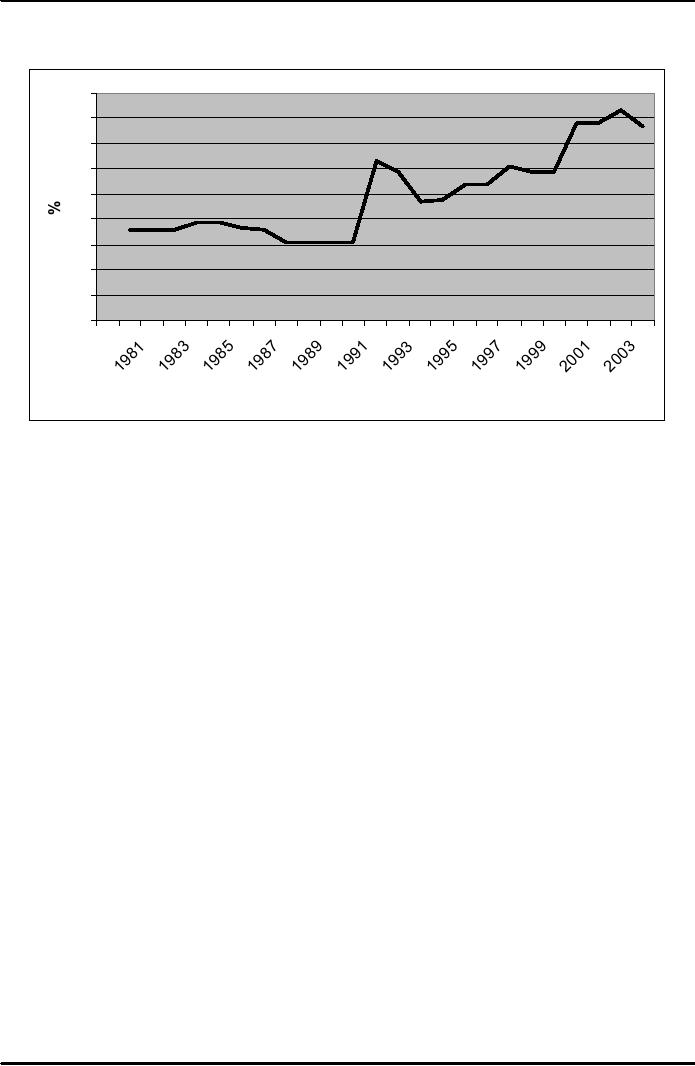 |
OPEN ECONOMY (Continued…):A first model of the natural rate |
| << OPEN ECONOMY (Continued…):The Determinants of the Nominal Exchange Rate |
| ISSUES IN UNEMPLOYMENT:Public Policy and Job Search >> |

Macroeconomics
ECO 403
VU
LESSON
17
OPEN
ECONOMY (Continued...)
Purchasing
Power Parity
(PPP)
�
def1:
a doctrine that states that
goods must sell at the
same (currency-adjusted)
price
in
all countries.
�
def2:
the
nominal exchange rate
adjusts to equalize the cost
of a basket of goods
across
countries.
�
Reasoning:
arbitrage, the law of one
price
�
PPP:
e xP
= P*
Where
e
x P -
Cost of a basket of domestic
goods, in foreign
currency.
P
-
Cost of a basket of domestic
goods, in domestic
currency.
P*
-
Cost of a basket of foreign
goods, in foreign
currency.
Solve
for e
:
e
=
P*/
P
PPP
implies that the nominal
exchange rate between two
countries equals the ratio
of the
countries'
price levels.
P
P* P
ε
=e� *
=
�
*
=1
P
PP
�
If
e = P*/P,
then
Does
PPP hold in the real
world?
No,
for two reasons:
1.
International arbitrage not
possible.
�
Non
traded goods
�
Transportation
costs
2.
Goods of different countries
not perfect
substitutes.
Nonetheless,
PPP is a useful
theory:
�
It's
simple & intuitive
�
In
the real world, nominal
exchange rates have a
tendency toward their PPP
values
over
the long run.
Issues
in Unemployment
The
natural rate of
unemployment:
�
What it
means
�
What
causes it
�
Understanding
its behavior in the real
world
Natural
Rate of Unemployment
�
Natural
rate of unemployment:
the
average rate of unemployment
around which the economy
fluctuates.
�
In a
recession, the actual
unemployment rate rises
above the natural
rate.
�
In a
boom, the actual
unemployment rate falls
below the natural
rate.
62

Macroeconomics
ECO 403
VU
Unemployment
Rate of Pakistan
9
8
7
6
5
4
3
2
1
0
Years
A
first model of the natural
rate
Notation:
L
=
# of workers in labor
force
E
=
# of employed workers
U
=
# of unemployed
U/L= unemployment
rate
Assumptions:
1.
L
is exogenously fixed.
2.
During
any given month,
s
= fraction of employed workers
that become separated from
their jobs,
f
= fraction of unemployed workers
that find jobs.
s
= rate of job separations, f =
rate of job finding
(both
exogenous)
Transitions
between employment and
unemployment
The
steady state
condition
�
Definition:
the labor market is in
steady state, or long-run
equilibrium, if the
unemployment
rate is constant.
�
The
steady-state condition
is:
s
xE
=
f
xU
number
of employed people who =
number of unemployed people
who find jobs
lose
or leave their jobs
63

Macroeconomics
ECO 403
VU
Solving
for the "equilibrium" U
rate
f
xU
= s
xE
=
s
x (L
U)
=s
Ls
U
Solve
for U/L:
(f
+ s)xU
= sxL
U
s
=
L
s +f
So,
Example:
�
Each
month, 1% of employed workers
lose their jobs (s =
0.01)
�
Each
month, 19% of unemployed
workers find jobs (f =
0.19)
�
Find
the natural rate of
unemployment:
U
s
0.01
=
=
=
0.05, or
5%
L
s +f
0.01
+
0.19
Policy
implication
�
A
policy that aims to reduce
the natural rate of
unemployment will succeed
only if it
lowers
s or increases f.
Why
is there unemployment?
�
If
job finding were
instantaneous (f = 1),
then
all spells of unemployment
would be brief, and the
natural rate would be
near
zero.
�
There
are two reasons why f <
1:
1.
Job search
2.
Wage rigidity
Job
Search & Frictional
Unemployment
�
Frictional
unemployment: caused by the
time it takes workers to
search for a job
�
Occurs
even when wages are
flexible and there are
enough jobs to go
around
Job
Search & Frictional
Unemployment
Occurs
because
�
Workers
have different abilities,
preferences
�
Jobs
have different skill
requirements
�
Geographic
mobility of workers not
instantaneous
�
Flow of
information about vacancies
and job candidates is
imperfect
64
Table of Contents:
- INTRODUCTION:COURSE DESCRIPTION, TEN PRINCIPLES OF ECONOMICS
- PRINCIPLE OF MACROECONOMICS:People Face Tradeoffs
- IMPORTANCE OF MACROECONOMICS:Interest rates and rental payments
- THE DATA OF MACROECONOMICS:Rules for computing GDP
- THE DATA OF MACROECONOMICS (Continued…):Components of Expenditures
- THE DATA OF MACROECONOMICS (Continued…):How to construct the CPI
- NATIONAL INCOME: WHERE IT COMES FROM AND WHERE IT GOES
- NATIONAL INCOME: WHERE IT COMES FROM AND WHERE IT GOES (Continued…)
- NATIONAL INCOME: WHERE IT COMES FROM AND WHERE IT GOES (Continued…)
- NATIONAL INCOME: WHERE IT COMES FROM AND WHERE IT GOES (Continued…)
- MONEY AND INFLATION:The Quantity Equation, Inflation and interest rates
- MONEY AND INFLATION (Continued…):Money demand and the nominal interest rate
- MONEY AND INFLATION (Continued…):Costs of expected inflation:
- MONEY AND INFLATION (Continued…):The Classical Dichotomy
- OPEN ECONOMY:Three experiments, The nominal exchange rate
- OPEN ECONOMY (Continued…):The Determinants of the Nominal Exchange Rate
- OPEN ECONOMY (Continued…):A first model of the natural rate
- ISSUES IN UNEMPLOYMENT:Public Policy and Job Search
- ECONOMIC GROWTH:THE SOLOW MODEL, Saving and investment
- ECONOMIC GROWTH (Continued…):The Steady State
- ECONOMIC GROWTH (Continued…):The Golden Rule Capital Stock
- ECONOMIC GROWTH (Continued…):The Golden Rule, Policies to promote growth
- ECONOMIC GROWTH (Continued…):Possible problems with industrial policy
- AGGREGATE DEMAND AND AGGREGATE SUPPLY:When prices are sticky
- AGGREGATE DEMAND AND AGGREGATE SUPPLY (Continued…):
- AGGREGATE DEMAND AND AGGREGATE SUPPLY (Continued…):
- AGGREGATE DEMAND AND AGGREGATE SUPPLY (Continued…)
- AGGREGATE DEMAND AND AGGREGATE SUPPLY (Continued…)
- AGGREGATE DEMAND AND AGGREGATE SUPPLY (Continued…)
- AGGREGATE DEMAND IN THE OPEN ECONOMY:Lessons about fiscal policy
- AGGREGATE DEMAND IN THE OPEN ECONOMY(Continued…):Fixed exchange rates
- AGGREGATE DEMAND IN THE OPEN ECONOMY (Continued…):Why income might not rise
- AGGREGATE SUPPLY:The sticky-price model
- AGGREGATE SUPPLY (Continued…):Deriving the Phillips Curve from SRAS
- GOVERNMENT DEBT:Permanent Debt, Floating Debt, Unfunded Debts
- GOVERNMENT DEBT (Continued…):Starting with too little capital,
- CONSUMPTION:Secular Stagnation and Simon Kuznets
- CONSUMPTION (Continued…):Consumer Preferences, Constraints on Borrowings
- CONSUMPTION (Continued…):The Life-cycle Consumption Function
- INVESTMENT:The Rental Price of Capital, The Cost of Capital
- INVESTMENT (Continued…):The Determinants of Investment
- INVESTMENT (Continued…):Financing Constraints, Residential Investment
- INVESTMENT (Continued…):Inventories and the Real Interest Rate
- MONEY:Money Supply, Fractional Reserve Banking,
- MONEY (Continued…):Three Instruments of Money Supply, Money Demand